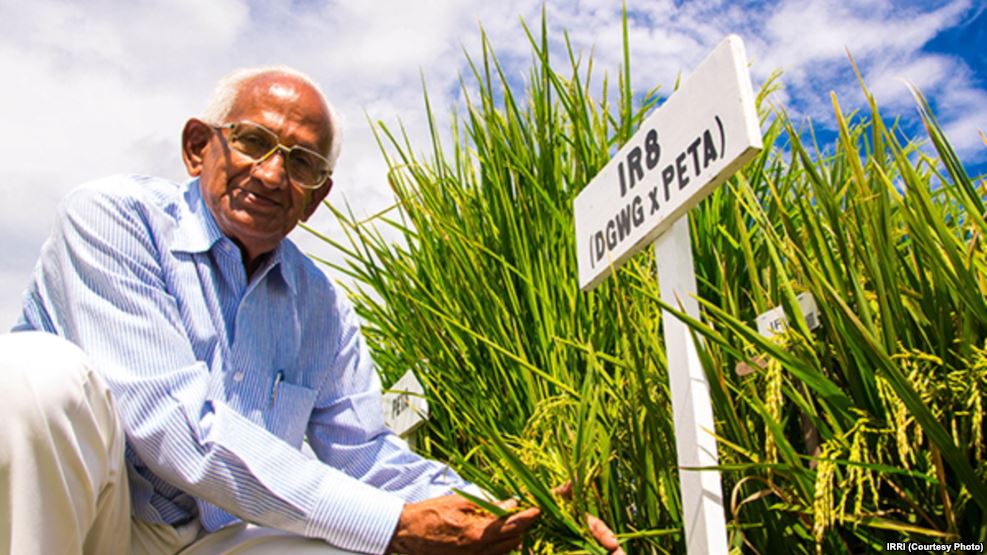
Back in 1966, a farmer named Nekkanti Subha Rao planted a new variety of rice in the southeastern Indian state of Andhra Pradesh.
The rice plant is called IR8. It was the creation of scientists at the International Rice Research Institute in the Philippines.
Scientists created the IR8 variety by combining a tall rice plant from Indonesia and a shorter version from China.
IR8 was the world’s first highly productive rice. It is credited with having prevented famines and providing food for millions of people.
Agricultural experts say IR8 rice is partly responsible for the Green Revolution, which began in the 1940s and continued through the 1960s. During this period, farmers increased their use of man-made fertilizers and pesticides, and irrigation systems to water crops. Food production sharply increased and helped prevent widespread hunger.
India and the International Rice Research Institute have been celebrating the 50th anniversary of IR8 rice, which became known as “miracle rice.”
Farmer Rao, now 80 years old, remembers his surprise when he harvested a shocking 7.5 tons of rice on every hectare.
“Never before,” he said. “Every farmer feeling very, very, very happy, happy. 100 percent success.”
Many Asian countries struggled with food shortages in the 1960s and 1970s. IR8 and other varieties that followed helped increase rice production in Asia by 200 percent. The increase helped prevent widespread hunger.
“It transformed agriculture,” said Dr. Nafees Meah, the institute’s representative for South Asia. He said the Green Revolution prevented the food crises that happened in those years. “It saved millions of lives.”
After India, IR8 rice was planted in other Asian countries, such as the Philippines, Vietnam and Cambodia, where rice is the main food for most people.
Agriculture experts say that the plant’s shorter length made IR8 rice stronger and less likely to fail before harvest time. And, it took less time to grow compared to local rice. So, farmers could plant more than one crop on the same land.
Recalling the Green Revolution
Even with the rise in food production, the Green Revolution also led to some long-term troubles.
As The New York Times reported, crops such as IR8 rice required heavy use of pesticides and chemical fertilizers.
This method of agriculture left behind chemical pollution, noted U.S. News & World Report magazine. It also used up a lot of soil nutrients, and eventually led to soil depletion. So, farmers needed more and more fertilizer, according to National Public Radio (NPR).
Crops like IR8 also needed more water than natural rainfall offered, so farmers had to irrigate the soil and build wells, NPR noted. In India, this caused the groundwater to sink as much as one meter each year.
This “package of practices” was costly, especially for poor farmers. Many of the farmers used credit to buy the products and services, but could not pay back their loans. So, they went into debt, lost their land, and were forced to move to crowded cities to find work. After they left, richer farmers bought their land.
There was very little work on the larger farms because farmers began turning to tractors and other modern equipment. So, human labor decreased, creating high rural unemployment in some areas.
Widespread planting of only one or two varieties of rice also reduced biodiversity. In the long-term, this can lead to the spread of disease among plants.
Feeding a growing world
The methods used during the Green Revolution saved nearly one billion people from starvation, according to the New York Times. However, experts are divided on whether the lasting results are more good than bad.
Today food security is still an issue, and not just for Asia. At the same time, malnourishment continues to affect millions of poor people on the continent. And everywhere, farmers are dealing with issues resulting from climate change.
Rod Wing is an American scientist at the International Rice Research Institute. He says developing new kinds of rice with more nutrients but less of a harmful effect on the environment can reduce our dependence on gases linked to climate change. The problem, he says, is that the rice must require less water, fertilizer, and pesticides.
In recent years, new kinds of rice that are more resistant to dry weather and floods are showing promising results in eastern India and Bangladesh, a country where floods used to cover or wash away crops.
A genetically engineered variety of rice has been developed to improve Vitamin A levels. Lack of Vitamin A kills many children under the age of five. In addition, researchers are developing crops that keep blood sugar lower and release energy slowly.
But the challenge of productivity that IR8 rice fueled remains, noted Wing. “The big question is…how are we going to feed three more billion people on the planet by 2050?”
And while some farmers are experiencing larger harvests, they continue to battle other problems. The cost of growing the rice is “very, very high now. Labor cost is high,” said farmer Rao.
I’m Bryan Lynn.
And I’m Alice Bryant.
Anjana Pasricha reported this story for VOANews.com. Alice Bryant adapted her report for Learning English. George Grow was the editor.
We want to hear from you. Write to us in the Comments Section.
_______________________________________________________________
Words in This Story
variety – n. a particular kind of person or thing
pesticide – n. a chemical that is used to kill animals or insects that damage plants or crops
transform – v. to change something completely – and usually in a good way
depletion – n. to use most or all of something important; to greatly reduce the amount of something
irrigate – v. to supply something (such as land) with water by using artificial means (such as pipes)
tractor – n. a large vehicle used to pull farm equipment
biodiversity – n. the existence of many different kinds of plants and animals in an environment
malnourishment – n. lack of proper nutrition
climate change – n. a change in global climate patterns caused by an increase in carbon dioxide resulting from the use of fossil fuels (coal and natural gas)
